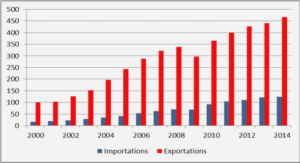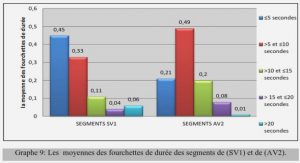The hypotheses of financial development (the causality relationship between FD and Economic growth)
The hypotheses come up with Patrick (1966); he identifies two possible causal relationships between financial development and economic growth. The first is called demand following hypothesis which mentions the demand for financial services as dependent upon the growth of real output and the commercialization and modernization of agriculture and other subsistence sectors. Thus, the creation of modern financial institutions, their financial assets and liabilities and related financial services are a response to the demand for these services by investors and savers in the real economy. On this view, the more rapid growth of real national income, the greater will be the demand by enterprises for external funds (the savings of others).
The postulation of this view is that causality runs from economic growth to financial development, in this case, an expansion, of the financial system is induced because of real economic growth.
The second causal relationship between financial development and economic growth is termed supply leading by Patrick (1966), supply leading has two functions, which are transferring resources from the traditional low-growth sector to the modern high-growth sector, promoting, and stimulating an entrepreneurial response in these modern sectors. This implies that the creation of financial institutions and their services occurs in advance of demand for them.
In this case and according to supply- leading argument, the effect runs from financial development to economic growth. The financial sector can stimulate economic growth through three different channels (Ferda, 2007 and Duenwald, 2002):
It results in an increase in the marginal productivity of capital, by collecting information to evaluate alternative projects and by risk sharing.
It raises the proportion of savings channeled to investments by means of financial development and thus, increases the efficiency of financial intermediation and 3- it increasing the private savings rate.
The impact of financial liberalization
In the last two decades an increasing number of countries have eliminated controls on international capital movements. Financial liberalization refers to banking sector liberalization, the deregulation of domestic financial markets and the liberalization of the capital account. The effects of financial liberalization have been a matter of some debate. In one view, it strengthens financial development and contributes to higher long run growth, according to McKinnon (1973) and Shaw (1973) who supports that when financial repression is destroyed and financial system is liberalized, financial deepening will exist and economic growth will increase. Same idea is followed by Fry (1988), Gablis (1977), Kapur (1976), and Mathieson (1980) in another view, and in contrast to McKinnon and Shaw’s view, Buffy (1984) and Wijnbergen (1983) were developed alternative idea who are called structuralism according to them, financial development decreases total real credit supply and prevents economic growth, according to Buffy (1984) “….if we give permission to reactions in markets then financial liberalization will be a dangerous enterprise.”
Financial repression before financial liberalization
In developing countries, the term financial repressed means that government holds financial markets under the repression by interfering them. It achieves this by distribution of credits with holding interest rates at low levels synthetically. However in fact, the hypothesis of financial repression depends on the criticisms of neoclassical and neo-Keynesian views about interest rate policies (Selda, 2009).
Financial repressed theory was first come up with in two independent studies belong to McKinnon (1973) and Show (1973), and financial markets were first examined systemically by McKinnon in 1973.
Above we saw, theoretically, that an economy with an efficient financial system can achieve growth and development through efficient capital allocation. McKinnon and Shaw argue that historically many countries, including developed ones but especially developing ones, have restricted competition in the financial sector with government interventions and regulations. According to their argument, a repressed financial sector discourages both saving and investment because the rates of return are lower that what could be obtained in a competitive markets. In such a system, financial intermediaries do not function at their full capacity and fail to channel saving into investment efficiently, thereby impeding the development of the overall economic system.
Rational for and policies of financial repression
The term financial repression became a way of describing emerging markets financial systems prior to the widespread financial liberalization that began in the 1980. Financial repression was also the norm for advanced economies during the post world war II and in varying degrees up through the 1980s.
The key reason for the government to implement financially repressive policies is to control fiscal resources by having a direct control over the financial system, the government can funnel funds to itself without going through legislative procedures and more cheaply that it could when it resorts to market financing. More specifically, by restricting the behavior of existing and potential participants of the financial markets, the government can create monopoly or captive rents for the existing banks and also tax some of these rents so as to finance its overall budget. Existing banks may try to collude with each other and to interrupt possible liberalization policies as long as they are guaranteed their collective monopoly position in the domestic market (Roubini et al., 1992).
McKinnon (1973) defines financial repression as follows: bank credit remains a financial appendage of certain enclaves, exclusively licensed import activities, specialized large-scale mineral exports, highly protected manufacturing, large international corporations and various government agencies. Even ordinary government deficits on current account frequently preempt the limited lending resources of the deposit banks. Financing the rest of the economy must be met from the meager resources of moneylenders, pawnbrokers and cooperatives. It is this phenomenon that he calls financial repression (McKinnon, 1973, p 69).
From his definition of financial repression we describe here some of its main features and policies. Typical policies that constitute financial repression and that are motivated by government’s fiscal needs include high reserve requirements, liquidity ratio requirements, interest ceilings and government directives on the direction of credit.
High rates of the reserve ratios
In some countries, governments require banks to meet high rates of the reserve ratios, and use the reserves as a method to generate revenues. Because reserves earn no interest, reserve requirements function as an implicit tax on banks and also restrict banks from allocating a certain Portion of their portfolios to productive investments and loans when high reserve ratios are required, the lending and borrowing rate spread must widen to incorporate the amount of no-interest reserves, which can reduce the amount of funds available in the financial market. If high reserve requirements are combines with interest ceilings and protective government directives for certain borrowers, savers who are usually unaware of the requirement policy become the main tax payers because they face reduced rates of interest on their savings.
Ceilings on interest rate
These interest rate ceilings could be affected through various means, including (Reinhart et al., 2011):
(a) Explicit government regulation. For instance, the government in the united state prohibited bank from paying interest on demand deposits and capped interest on saving deposits.
(b) In many cases ceilings on banks’ lending rates were a direct subsidy to the government in cases where the government borrowed directly from the banks.
(c) The interest rate cap could be in the context of fixed coupon rate nonmarketable debt. (d) Or it could be maintained through central bank interest rate targets.
Financial repression also takes the form of government directives for banks to allocate
credit at subsidized rates to specific firms and industries to implement industrial policy.
Forcing banks to allocate credit to industries that are perceived to be strategically important for industrial policy ensures stable provision of capital, rather than leaving it to decisions of disinterested banks or to efficient securities markets. It is also more cost effective than going through the public sector’s budgetary process.
D. Capital controls are restrictions on the inflows and outflows of capital and are also financially repressive policy. Despite their virtues, the use of capital controls can involve costs. Because of their uncompetitive nature, capital controls increases the cost of capital by crating financial autarky, limits both domestic and foreign investors ability to diversify portfolios, and helps inefficient financial institutions survive.
Adding other instruments of financial repression such as:
-Loan decisions of state owned banks dictated by political factors.
-Absence of a competitive system, where most domestic banks are state owned.
-Restrictions on the composition of asset portfolios.
Effects of financial repression
Because financial repression leads to inefficient allocation of capital, high costs of financial intermediation, and lower rates of return to savers, it is theoretically clear that financial repression inhibits growth (Roubini et al., 1992).
The Mckinnon-Shaw framework suggests that interest rate controls, particularly interest rate ceilings, may distort the economy in several ways. First, it may discourage entrepreneurs from investing in high risk but potentially high-yielding investment projects. Second, financial intermediaries may become more risk averse and offer preferential lending to established borrowers. Third, borrowers who obtain their funds at relatively low cost may prefer to invest only in capital intensive projects.
Figure (2) shows the McKinnon- Shaw Financial repression, where McKinnon and Shaw were the first to provide a theoretical analysis of financially repressed economies which offered a rationale for liberalization as means to promote financial development and hence growth. Their models focus specifically on financial repression in the form of ceilings on deposit and \ or loan interest rates. Real interest rates influence growth in the economy via their impact on savings and investment. Investment (I) is assumed to be a negative function of the real rate of interest (r):
According to Gibson and Tsakalots (1992), the figure above shows the impact of an interest rate ceiling on savings and investment. The savings function is drawn for given rates of economic growth where ?1 < ?2 <?3. If there were no ceiling imposed, equilibrium, would be at E, interest rate, r* and investment and savings equal to I *. Assume initially that there is a government imposed ceiling (ceiling 1) on nominal deposit interest rates (i.e. the interest rate received by severs) which ensures that real deposit rates are below their equilibrium level given by r*. Assume additionally that the rate of economic growth is ?1 . at a real deposit rate of ?1, ?1 savings are forthcoming. Given that banks can charge whatever interest rate they like on loans, ?1 investment will be demanded at interest rate ?3. The margin which banks make on lending activities ( ?3-?1) is likely to be used for non- price competition. It is more likely that interest rate ceilings will apply to loan rates as well as deposit rates, since government regulation is frequently aimed at encouraging investment through reducing the cost of borrowing. This indeed was, and to some extent still is the case in Greece, Portugal, and Spain. Assume therefore that ceiling 1 applies both to the deposit and the loan rate. Again ?1 savings are forthcoming, allowing ?1 investment to be financed. This implies that investment demand given by AB is unsatisfied. In other words, credit has to be rationed and some entrepreneurs with profitable projects will not have access to finance. Moreover, those projects which are financed will tend to have rates on return which are only just greater than the interest rate ceiling. The justification for this in the literature seems to be based on the idea that given that there is credit rationing; banks prefer to give the available funds to less risky projects. Thus, a large proportion of unsatisfied investment (AB) is likely to include potentially more profitable projects that were not allocated funds because of the risk.
Presumably, these results from the inability of banks to charge risk which would allow them to finance potentially higher return investments. What happens if the government raises the interest rate ceiling say to ceiling 2? This increases the efficiency of investment (since entrepreneurs are now undertaking projects with higher expected rates of return), the rate of economic growth rises from ?1 ?? ?2 and the savings function shifts to the right. Thus the new interest rate ceiling at ?2 encourages savings of ?2. credit rationing is still present, but it has been reduced to CD. Only when interest rates are fully liberalized does credit rationing disappear. Economic growth increases to ?3 and the equilibrium savings and investment is at E.
Thus the McKinnon- Shaw analysis of a financially repressed economy suggests that interest rate ceilings stifle savings by promoting current consumption, reduce investment below its optimal level and reduce the quality of investment by encouraging banks to finance only low- return projects.
The McKinnon Shaw school of thought proposes that government restrictions on the operation of the financial system, such as directed credit programs, reserve and liquidity requirements may inversely affect the quality and quantity of investment and thus hinder financial development.
Reserve requirements held by banks reduce the inherent liquidity problems in banking.
This affect bank lending, since banks have to hold unproductive reserves, for each level of loans they issue, they have to charge a higher lending rate. In other words at any given lending rate they will supply less loans, and the supply of loans will shift to left.
A number of writers question the wisdom of financial repression, arguing that it has detrimental effects on the real economy. Goldsmith (1969) argued that the main impact of financial repression was the effect on the efficiency of capital. McKinnon (1973) and Shaw (1973) stressed two other channels: first, financial repression affects how efficiently savings are allocated to investment, and second, through its effect on the return to saving, it also affects the equilibrium level of saving and investment. In this framework, therefore, investment suffers not only in quantity but also in quality terms since bankers do not ration the available funds according to the marginal productivity of investment projects but according to their own discretion. Under these conditions the financial sector is likely to stagnate. The low return on bank deposits encourages savers to hold their savings in the form of unproductive assets such as land, rather than the potentially productive bank deposits. Similarly, high reserve requirements restrict the supply of bank lending even further whilst directed credit programs distort the allocation of credit since political priorities are in general, not determined by the marginal productivity of different types of capital.
The policy implications of this analysis are quite straight forward: remove interest rate ceilings, reduce reserve requirements and abolish directed credit programs. In short, liberalize financial markets.
The process of financial liberalization
McKinnon and Shaw consider financial liberalization as a mainstay of economic reforms in developing countries. McKinnon goes as far as to define economic development as “the reduction of the great dispersion in social rates of return to existing and new investments under domestic entrepreneurial control”.
Financial liberalization is the process of breaking away from a state of financial repression. As financial repression has been most commonly associated with government fixing of interest rates and its adverse consequences on the financial sector as well as on the economy, financial liberalization, in turn, has come to be most commonly associated with freeing of interest rates. This is pretty much the old view. They now understand financial liberalization as a process involving a much broader set of measures geared toward the elimination of various restrictions on the financial sector, such as the removal of portfolio restrictions on the banking sector, the reform of the external sector, as well as changes in the institutional framework of monetary policy (Ucer, 2003).
|
Table des matières
Introductory Chapter
1.1. Preface
1.2. Research Problematic
1.3. Research Hypothesis
1.4. Importance of the Study
1.5. Objectives of the Study
1.6. Justification for the choice of subject
1.7. Data and Methodology
1.8. Previous Studies
1.9. Difficulties of the Study
1.10. Limitations of the Study
1.11. Structure of the Study
Chapter Two: Theoretical Framework
Introduction
2.1. The importance of financial development sector
2.1.1. Defining financial system
2.1.2. Structure of a Financial System
2.1.3. The role of banking sector on economy
2.1.4. What is financial development?
2.1.5. The relationship between FD and Economic growth
2.1.6. The hypotheses of financial development
2.2. The impact of financial liberalization
2.2.1. Financial repression before financial liberalization
2.2.1.1. Rational for and policies of financial repression
2.2.1.2. The effects of financial repression
2.2.2. The process of financial liberalization
2.2.2.1. The theoretical arguments for financial liberalization
2.2.2.2. Elements of financial liberalization
2.2.2.3. The McKinnon Shaw paradigm (analysis)
2.2.2.4. Extensions and criticisms of the McKinnon Shaw approach
2.2.2.5. Financial liberalization and banking performance and efficiency
2.2.2.6. Potential benefits qualifications and risks to liberalization
Conclusion
Chapter Three: Empirical Evidence
Introduction
3.1. East Asia and Pacific
3.2. Europe and Central Asia
3.3. Latin America and the Caribbean
3.4. Sub-Saharan Africa
3.5. Middle East and North Africa
3.6. South Asia
Conclusion
Chapter Four: Banking System Reform
Introduction
4.1. Algerian banking system under financial repression
4.1.1. From 1962 to 1979
4.1.2. From 1980 to 1989
4.2. Financial liberalization of the Algerian banking system
4.2.1. Algerian banking system under the law 90/10
4.2.2. Development of the Algerian banking system after the law of 90/10
4.2.3. The Adoption of the financial liberalization in the Algerian banking system
Conclusion
Chapter Five: Econometric Methodology and Results Discussion
Introduction
5.1. General Framework and Objectives of the Econometric Study
5.2. The Decision Rule
5.3. Data, Methodology and the Model Used
5.3.1. Data
5.3.2. Research Methodology and Model Specification
5.3.2.1. Research methodology
5.3.2.2. Model specification
5.4. Presentation and interpretation of empirical results
5.4.1. Results of stationary tests
5.4.2. Results of first selections
5.4.3. Results of second selections
5.4.4. Results of third selections
5.4.5. Results of fourth selections
5.5. Results discussion
Conclusion
General Conclusion
References
Appendixes
![]() Télécharger le rapport complet
Télécharger le rapport complet





